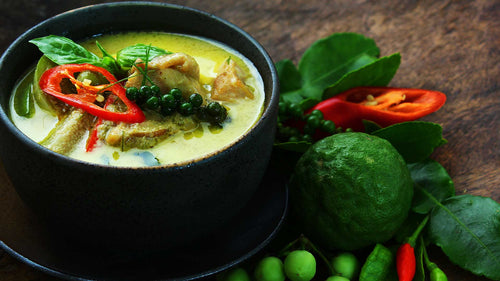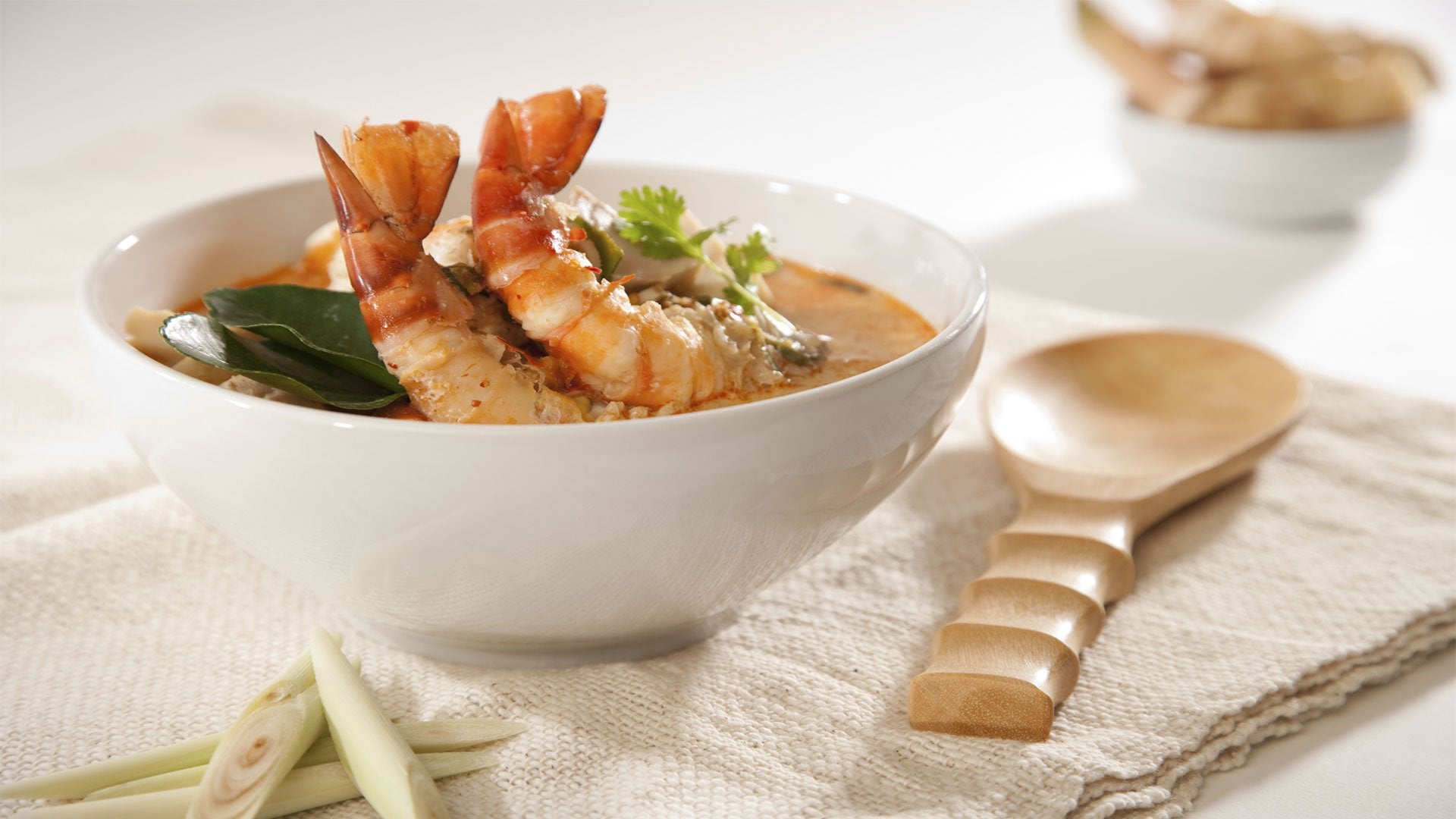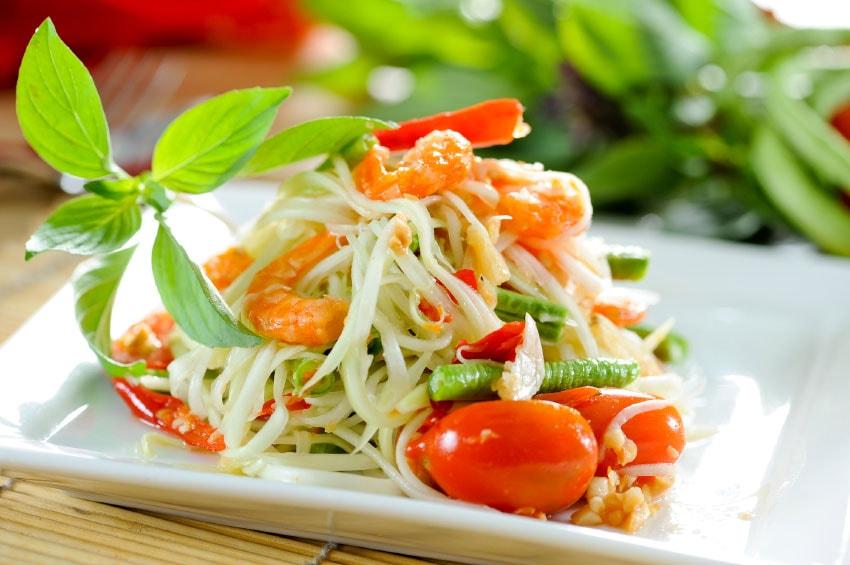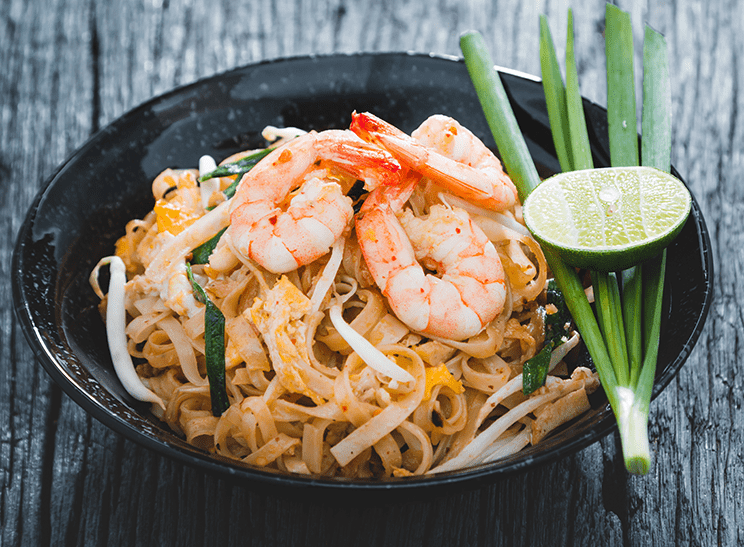What are kaffir lime leaves and where do they come from?
Kaffir lime leaves are a well loved ingredient in Thai cuisine and can be found on the variety of limes native to Southeast Asia, kaffir limes. Kaffir limes are also known as Thai Limes or Makrut across the world. These fragrant leaves (and the fruit) are widely used in Thai cuisine, adding a fresh and zesty flavour to classic recipes either for taste or to balance out other strong ingredients. While kaffir lime leaves appear to be a simple ingredient, they boast a range of uses and benefits in Thai and other Southeast Asian cuisine including Laotian, Indonesian, Vietnamese and more. In this blog, we’ll be sharing a quick guide to everything you should know to make the best use of kaffir lime leaves.
What are kaffir lime leaves used for?
In cooking, kaffir lime leaves are more often used than their fruit. In Thai cuisine, they are a key ingredient in popular recipes such as Thai green curry, Thai red curry and tom yum soup. In Indonesian cuisine, they are used in the noodle soup recipe soto ayam and in Cambodian cuisine, kaffir lime leaves are used to prepare a traditional spice marinade paste called Kroeung.
It’s clear the uses for these leaves are widespread, much like other western herbs such as fresh basil, mint and coriander leaves. However, they can be best compared to Indian bay leaves which similarly, are used to infuse fragrance and flavour to dishes. The key difference is that unlike many Indian recipes, kaffir lime leaves can be a consumed ingredient in a lot of dishes (especially the ones which call for the leaves to be shredded or blended).
So kaffir lime leaves can be used in a variety of ways from being added to curries during the later stages of cooking, stirred into soups and stir fries or blended into pastes and marinades to soak other ingredients with pungent flavours.
What do kaffir lime leaves taste like?
Imagine the taste of regular limes but more pungent, tangy and blended with the flavour of a very mild basil - this is a close description but still doesn’t quite describe the truly unique flavour of kaffir lime leaves. However, as with any other citrus ingredient, kaffir lime leaves have a distinct fresh and zesty flavour with an additional unique herby undertone. This is very similar to how the leaves smell, once inhaled, almost anyone could agree that kaffir lime leaves have an aroma deliciously memorable.
How to prepare kaffir lime leaves
Kaffir lime leaves can come in a variety of forms; either fresh, frozen or dried. Despite this, they are generally prepared in similar ways. Because the leaves essentially do add flavour and fragrance to recipes, to prepare them, they need to be ‘bruised’ or pierced to release a more potent aroma. This is easier to do with fresh kaffir lime leaves, which are typically either twisted to create small cuts or shredded/chopped into strips depending on the recipe.
When it comes to frozen kaffir lime leaves, these would need to be defrosted before use and you may opt to very gently muddle them with a pestle and mortar to release extra flavour. Dried kaffir lime leaves are typically best to use in hydrating recipes such as soups and broths, this not only softens their texture but the heat from the recipe helps to infuse their flavours.
Out of the three main forms, fresh kaffir lime leaves are typically ideal to use for the best fragrance and flavour in recipes, however, frozen and dried varieties are also great choices depending on what the recipe calls for.
Thai recipes which use kaffir lime leaves
Used to prepare the curry paste and again to add fragrance once the curry has been cooked, kaffir lime leaves are one of the key ingredients in a Thai green curry. They not only add the depth of flavour well known in Thai green curry but also add to the colour of the finished dish, along with Thai sweet basil.
In this recipe, kaffir lime leaves are shredded and added to the corn fritter batter. A simple use of the ingredient which yields delicious results. For this recipe which involves deep frying, fresh kaffir lime leaves are ideal because they are cut into pieces to release the best taste.
In Tom Yum soup, kaffir lime leaves compliment the range of other herbs and spices used in the recipe such as galangal and lemongrass to create the classic rich, sour and tangy flavour. They can also be used as an additional garnish for a dish that looks and smells just as good as it tastes.











Leave a comment